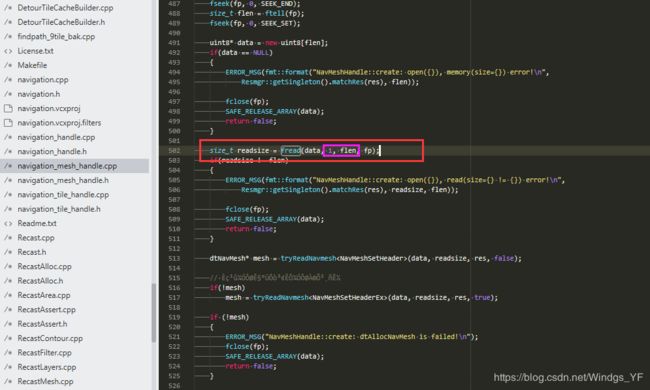fopen-fread-fwrite-open-read-write原理源码详解
最近在研究kb引擎的时候,看recast源码和navmesh源码中的数据加载时候看到了fread和fwrite,发现有两种不同的写法,请看下面的图示。突然间想起来,2种不同的写法效率是否会不同那,所以就想看看底层系统函数的源码,于是乎
recast源码写法
kb源码
研究了一下fwrite, write,printf的实现原理, 给大家分享一下,给大家展示一下
一. 代码片段
#include
#include
#include
#include
int main(int argc,char**argv)
{
char buffer[]="hello world";
//使用'printf' 进行打印
printf("%s",buffer);
//使用'fwrite' 进行打印
//fwrite(buffer, 1, strlen(buf), stdout);
fwrite(buffer, strlen(buf), 1, stdout);
//使用'write' function to print char
write(STDOUT_FILENO, &buf, strlen(buf));
return(0);
}
执行结果
hello world
hello world
hello world
二.具体实现原理
实现原理是如何的那?
在unix下对文件的操作有2组系统函数
第一组:fopen, fread, fwrite
fopen 系列是标准的C库函数
第二组:open, read, write
open系列是 POSIX 定义的,是UNIX系统里的system call 文件句柄(file handles) ,也称文件结构指针, 文件描述符(file descriptors)是一个整形变量, 我们常知道的, stdout(标准输出), stdin(标准输入), stderr(标准错误),其实都是文件句柄,每一个文件句柄都会对应1个文件描述符,stdout, stdin, stderr,正好对应文件描述0,1,2
fread和fwrite接口
NAME
fread, fwrite - binary stream input/output
SYNOPSIS
#include
size_t fread(void *ptr, size_t size, size_t nmemb, FILE *stream);
size_t fwrite(const void *ptr, size_t size, size_t nmemb, FILE *stream);
三. 分析实现原理
os是px4使用的nuttx。
3.1 nuttx的配置选项
# CONFIG_STDIO_DISABLE_BUFFERING is not set
CONFIG_STDIO_BUFFER_SIZE=32 #配置文件的缓冲区大小
CONFIG_STDIO_LINEBUFFER=y #是否打开文件缓冲
3.2 nuttx的文件句柄和文件描述符的定义
3.2.1 文件结构体
文件位置NuttX/nuttx/include/nuttx/fs/fs.h, 文件结构中,包含了描述文件的缓冲区,这个是文件结构的很大的特点
#if CONFIG_NFILE_STREAMS > 0
struct file_struct
{
int fs_fd; //绑定的文件描述符
#ifndef CONFIG_STDIO_DISABLE_BUFFERING
sem_t fs_sem; /* For thread safety */
pid_t fs_holder; /* Holder of sem */
int fs_counts; /* Number of times sem is held */
FAR unsigned char *fs_bufstart; //执行缓冲区的头部,缓冲是f_open动态分配的
FAR unsigned char *fs_bufend; /* Pointer to 1 past end of buffer */
FAR unsigned char *fs_bufpos; /* Current position in buffer */
FAR unsigned char *fs_bufread; /* Pointer to 1 past last buffered read char. */
#endif
uint16_t fs_oflags; /* Open mode flags */
uint8_t fs_flags; /* Stream flags */
#if CONFIG_NUNGET_CHARS > 0
uint8_t fs_nungotten; /* The number of characters buffered for ungetc */
unsigned char fs_ungotten[CONFIG_NUNGET_CHARS];
#endif
};
3.2.2 文件描述符的定义
linux的每个文件描述符,都绑定了1个静态的file opreation的文件接口,绑定了f_priv驱动的对象,操作底层的寄存器
struct file
{
int f_oflags; /* Open mode flags */
off_t f_pos; /* File position */
FAR struct inode *f_inode; /* Driver or file system interface */
void *f_priv; /* Per file driver private data */
};
/* This defines a list of files indexed by the file descriptor */
#if CONFIG_NFILE_DESCRIPTORS > 0
struct filelist
{
sem_t fl_sem; /* Manage access to the file list */
struct file fl_files[CONFIG_NFILE_DESCRIPTORS];
};
3.2.3 标准输入输出的流
这个文件句柄,是每个线程创建的时候,自动创建的,自动绑定到文件描述符0,1,2上
#define stdin (&sched_getstreams()->sl_streams[0])
#define stdout (&sched_getstreams()->sl_streams[1])
#define stderr (&sched_getstreams()->sl_streams[2])
3.2.4 posix的标准接口定义
struct file_operations
{
/* The device driver open method differs from the mountpoint open method */
int (*open)(FAR struct file *filep);
/* The following methods must be identical in signature and position because
* the struct file_operations and struct mountp_operations are treated like
* unions.
*/
int (*close)(FAR struct file *filep);
ssize_t (*read)(FAR struct file *filep, FAR char *buffer, size_t buflen);
ssize_t (*write)(FAR struct file *filep, FAR const char *buffer, size_t buflen);
off_t (*seek)(FAR struct file *filep, off_t offset, int whence);
int (*ioctl)(FAR struct file *filep, int cmd, unsigned long arg);
/* The two structures need not be common after this point */
#ifndef CONFIG_DISABLE_POLL
int (*poll)(FAR struct file *filep, struct pollfd *fds, bool setup);
#endif
#ifndef CONFIG_DISABLE_PSEUDOFS_OPERATIONS
int (*unlink)(FAR struct inode *inode);
#endif
3.3.1 fopen接口实现过程
FAR FILE *fopen(FAR const char *path, FAR const char *mode)
//打开文件描述符
fd = open(path, oflags, 0666);
//把文件句柄绑定到os中
-> ret = fs_fdopen(fd, oflags, NULL);
//动态文件缓冲区, 确定start和end的位置,
stream->fs_bufstart = group_malloc(tcb->group, CONFIG_STDIO_BUFFER_SIZE);
stream->fs_bufend = &stream->fs_bufstart[CONFIG_STDIO_BUFFER_SIZE];
stream->fs_bufpos = stream->fs_bufstart;
stream->fs_bufread = stream->fs_bufstart;
//绑定文件描述到os的流中
stream->fs_fd = fd;
};
3.3.2 fwrite接口的实现
size_t fwrite(FAR const void *ptr, size_t size, size_t n_items, FAR FILE *stream)
-> size_t full_size = n_items * (size_t)size;
-> bytes_written = lib_fwrite(ptr, full_size, stream); //写入全部字节
//先数据写到文件缓存区中
for (dest = stream->fs_bufpos; gulp_size > 0; gulp_size--)
*dest++ = *src++;
//缓冲区满了,才写入到写到真正的设备上
if (dest >= stream->fs_bufend)
int bytes_buffered = lib_fflush(stream, false);
-> bytes_written = write(stream->fs_fd, src, nbuffer);
3.3.3 fread实现过程
size_t fread(FAR void *ptr, size_t size, size_t n_items, FAR FILE *stream)
bytes_read = lib_fread(ptr, full_size, stream);
//如果缓冲区有数据,直接先从缓冲区拿到数据
while ((count > 0) && (stream->fs_bufpos < stream->fs_bufread))
*dest++ = *stream->fs_bufpos++;
count--;
}
buffer_available = stream->fs_bufend - stream->fs_bufread;
//如果数据不够,就直接从文件中读取
-> if (count > buffer_available)
bytes_read = read(stream->fs_fd, dest, count);
//如果需要的数据,小于缓冲区容纳的大小,那么读取整个缓冲区的大小
-> if (count 《 buffer_available)
bytes_read = read(stream->fs_fd, dest, buffer_available);
3.4 printf接口实现
printf的最底层函数是up_putc() 这个函数,就是smt32阻塞等待发送完成,而且,这个up_putc可以被任何地方调用
int printf(FAR const IPTR char *fmt, ...)
int vfprintf(FAR FILE *stream, FAR const IPTR char *fmt, va_list ap)
->lib_stdoutstream(&stdoutstream, stream);
-> outstream->public.put = stdoutstream_putc;
-> result = fputc(ch, sthis->stream);
-> ret = lib_fwrite(&buf, 1, stream); // 下面就和fwrite的实现就一样了
-> if (dev->isconsole)
-> ret = uart_irqwrite(dev, buffer, buflen);
->uart_putc('\r'); // #define uart_putc(ch) up_putc(ch)
-> void up_lowputc(char ch)
-> while ((getreg32(CONSOLE_BASE+A1X_UART_LSR_OFFSET) & UART_LSR_THRE) == 0);
putreg32((uint32_t)ch, CONSOLE_BASE+A1X_UART_THR_OFFSET);
-> n = lib_vsprintf(&stdoutstream.public, fmt, ap);
-> obj->put(obj, FMT_CHAR);
if (FMT_CHAR == '\n')
(void)obj->flush(obj); //刷新
3. 5文件系统挂载
文件系统的挂载是我一直疑惑的问题,这此终于明白了文件系统的挂载的问题,块设备和字符设备的区别在于,字符设备
驱动注册设备节点,同时open, write可以直接操作字符设备, 而块设备的注册,并不是直接给write用的,而是给文件系统用的,文件系统注册到挂载点上,挂载点去操作文件,块设备,不像字符设备驱动一样,可以单个字节处理,而flash的特性是扇区处理,一般SD卡扇区是512字节
union inode_ops_u
{
FAR const struct file_operations *i_ops; /* Driver operations for inode *//
FAR const struct mountpt_operations *i_mops; /* Operations on a mountpoint */
};
//挂载文件系统
if mount -t vfat /dev/mmcsd0 /fs/microsd
//mount.c
mountpt_inode->u.i_mops = mops; //文件系统和设备节点挂载好
3.6 sd卡文件的write操作
这个sd卡文件的操作流程, posix的write调用文件系统fat_write,再调用驱动的mmcsd_write
ssize_t write(int fd, FAR const void *buf, size_t nbytes)
//fat文件系统接口的write
ret = fat_hwwrite(fs, userbuffer, ff->ff_currentsector, nsectors);
//调用mmcsd卡的驱动接口
-> ssize_t nSectorsWritten =
inode->u.i_bops->write(inode, buffer, sector, nsectors);
->mmcsd_write,/* mmcsd 写*/
通过以上的分析,我们的fread和fwrite,还用printf都是带缓冲,fwrite写的内容被刷新到sd卡的条件是,缓冲区满了,才会写到物理sd, fread是每次从物理扇区读取缓冲区的数据,比如,缓冲是32字节,fread要获取10字节,fread也直接读取32字节,缓冲到文件的缓冲区了,剩下的22字节,下次如果用户调用fread的时候,读取10字节,10字节小于缓冲区剩余的22字节,可以直接从缓冲区读走,这样可以提高缓冲区的大小。printf具有字节独立的特性,由于printf处理的都是字符,那么高效的处理方法就是判断是否接收到回车符号,就可以刷新缓冲区,而fgetc是,等待接收的数据中有了回车符号,才进行处理。
块设备 【fwrite【c库】->write【系统调用】->fat_write【文件系统】->mmcsd_write【SD驱动】】
字符设备 【fwrite【c库】->write【系统调用】->serial_write【串口驱动】】

